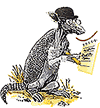
Question by Frontier Reporter, Late May 1875:
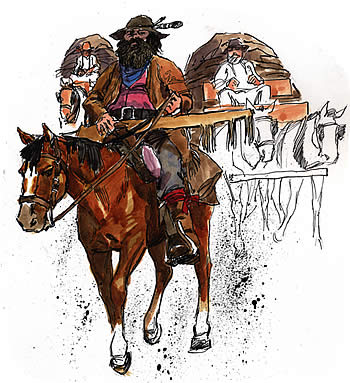
Whooey!
Looks like you fellows could do with a speck of soap and water. What brings you here to The Flat?
Buffalo Hunter answers:
To make some money, I hope. Do you see all those wagons lining up behind me? They're mine. They're piled high with 2,000 buffalo hides, each one cured and ready to sell. My name's Joe McComb. I'm a buffalo shooter. Meet Poe and Jacobs, my associates. They're skinners. We rode into The Flat today to meet a buyer named Charley Rath. Folks say he's opened a hideyard...that he not only buys but ships the hides. That saves us from having to haul them over to Ft. Worth. We hear he pays $2 for clean hides, ones without cuts or holes. If that's the case, we'll make a tidy profit. My skinners are careful. Their knives don't slip and cut the hide when they skin the carcass.
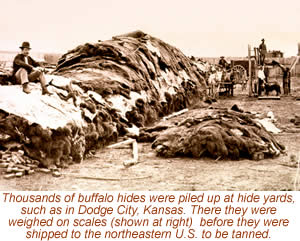
Ahhhh! This noisy, dusty town is a sight for sore eyes. To think that it was only six months ago that we left here. It must have been just around Thanksgiving when I got it in my head to rig up a buffalo hunt. I'd never been on one before. But there's big money in buff hides right now. I discovered that back in '71 when I trailed cattle to Dodge. There I saw tens of stacks of buffalo hides stockpiled by the railroad tracks. Those stacks were as high as a man standing in a wagon could throw them. A railroad man told me that tons of hides were being shipped to the East. Factories use them for machinery belts. People wear them as robes or cover their floors and walls with them.
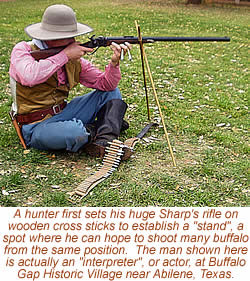
He said that the hides are in great demand. Brokers are paying top dollar for them. I thought of the thousands of buffalo that grazed freely in West Texas between October and May. But that was in Indian Territory. Few white men had ever even set foot there, much less hunted the Indian's prey.
But a lot has happened in the three years since my visit to Dodge. Col. MacKenzie and his soldiers have pushed more and more of the troublesome Indians out of the Llano Estacado and back onto the reservation at Ft. Sill. Now the area is open to white buffalo hunters.
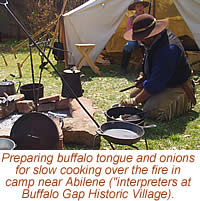
So Poe, Jacobs, and I decided to make a go of it. We put together provisions and a camp outfit and, on the day after Christmas, were ready to roll. We struck camp at Mocking Bird Springs—west of the Old Stone Ranch—and miles away from any settlement or home.
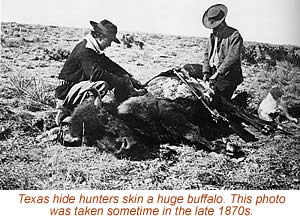
We knew we were flirting with an attack by rogue Indians. But we felt confident that our big, long-range guns would keep any enemy at a distance.
It was a freezing cold winter. Many chilly mornings we emerged from our flimsy tents to find a white world of snow. The cold, especially a norther, brought with it thousands of buffalo. We hunted in the morning and skinned in the afternoon. First, we located a herd. Then I took a stand downwind of it. I set up my Sharps .44 on a stake and waited. I studied the herd, picking out the leader, usually a bull. I shot it first. When it fell, the other buffs would mill about, dazed, until another bull took over the leadership. This would start a stampede. In all this confusion, I was able to pick off another 25 to 50 buffalo before the herd had enough sense to run off or scatter. Then the skinners would do their work. We went on like this, day after day, month after month, moving camp only once, until the herd began to migrate north last month. Now our hard work is over. It's time to sell our haul and reap our reward.
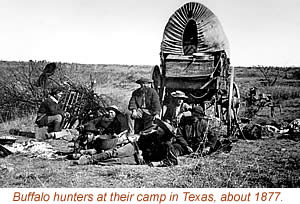
I think we are just about to wear out our welcome here at the Flat. Having brought the hides down this main street may not have been a good idea. Notice the horses tied up in front of that saloon. They're getting very restless. They're snorting and pulling at their reins, threatening to pull loose from their hitching posts and run away. It's because they've smelled the hides in our wagons. We'd better get a move on. Otherwise, some tanked up gambler might burst from that saloon, find his horse had bolted, and come looking for my hide!
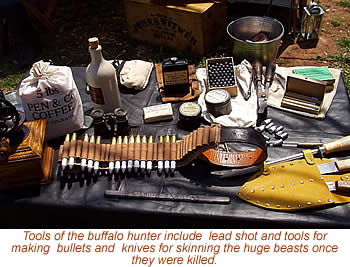
Credits and sources: Character dialogue by Lisa Waller Rogers; top painting by Charles Shaw; photos of interpreters and tools of buffalo hunter taken at Buffalo Gap Historic Village, Texas; photos of Texas hide hunters skinning buffalo and in camp with wagon, courtesy of the Texas State Library and Archives.
